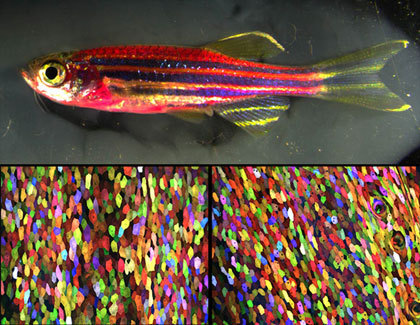#skinbow
In really surreal science news of the day, researchers have now found a way to watch how hundreds of individual cells work together to maintain and regenerate skin tissue, thanks to a genetically engineered line of technicolor zebrafish.

(To the naked eye, this genetically engineered zebrafish has a magenta tone (top). But under a microscope, every cell has a distinct color, thanks to a new labeling technique called Skinbow (bottom). Photo credit: Chen-Hui Chen, Duke University)
Ken Poss, a professor of cell biology at Duke University, and his lab have spent the last few years creating “Skinbow,” a mutant zebrafish with fluorescent markers embedded in the DNA code of its skin cells. Their study was published on March 21st, 2016 in Developmental Cell, and is available for free download: Multicolor Cell Barcoding Technology for Long-Term Surveillance of Epithelial Regeneration in Zebrafish.
Each of Skinbow’s color markers can be expressed in three different ways, resulting in red, green, or blue fluorescence. With three color options and roughly a hundred copies of the gene per cell, the total number of colors any cell can take on is probably in the thousands.
The research team has now been able to observe tissue regeneration by scraping a few cells off the fish’s fin, and visualize the healing process on a cellular level. Any color patterns that develop during tissue regeneration are inferred to arise from a single cell.
“It is like you have given each cell an individual barcode,”said Chen-Hui Chen, a postdoctoral fellow in Poss’s lab and lead author on the study. “You can precisely see how individual cells collectively behave during regeneration.”
Listen to Ken Poss discuss the experiment:
“One thing we weren’t expecting is that within a few hours of injury, cells that are spared acquire some mobility on the surface,”Posssaid in an interview with Gizmodo. “They also expand in size, some doubling. Then there’s a quick wave of replacement—you can see new cells emerging from the layer underneath.”
What is even more fascinating is that cells behaved differently in function of the injury. For example, following fin amputation, pre-existing cells were initially recruited from below the amputation plane to cover the wound. Then, new cells were generated at a rapid pace, and in the end some cells at the tip of the regrown tissue temporarily grew in size to provide surface coverage.

(Here, the multicolor cells are evident on the exposed portion of a dissected scale. Photo credit: Chen-Hui Chen, Duke University)
Poss is hopeful that the Skinbow technique can be extended to other species in the future, even humans. It obviously would involve getting the right set of genetic tools, and developing a way to image tissue continually over time, but Poss is hopeful that doctors may be able to use this technology to visualize how human tissue responds to new cancer drugs, or treatments meant to accelerate healing.
